After reading on the H1B visa overview and gaining a general idea of what an H1B visa petition is, the next step is to learn about what a professional with at least a bachelor’s degree working in a specialty occupation would need to provide as evidence to prove that they are qualified for an H1B work visa.
The article below provides a brief overview of what the H1B visa requirements are looking for and what documents are usually submitted for each requirement.
- 1.
- a.
- b.
- c.
- d.
- e.
- f.
- g.
- h.
- 2.
- a.
- b.
- c.
Table of Contents
In an H1B visa petition, it must be shown that (1) the job position offered under the H1B visa petition qualifies under the definition of a specialty occupation (which is a professional job position that requires at least a bachelor’s degree (or its equivalent) to conduct theoretical and practical application of a body of highly specialized knowledge, (2) the H1B visa worker has the qualifications to work in that job position (which typically means that the H1B visa worker has a bachelor’s degree in that specific field or has the equivalent work experience), and (3) the U.S. sponsoring employer has the business need and ability for such an H1B visa worker.
The following sections consist of a brief summary on each requirement and the documents that are generally used as evidence to satisfy that requirement.
SPECIALTY OCCUPATION
The H1B visa job offered must be in a specialty occupation
The H1B visa petition requires the job offered by the U.S. sponsoring employer to be categorized as a “specialty occupation” that (1) requires theoretical and practical application of a body of highly specialized knowledge and (2) the minimum entry into the occupation requires at least a bachelor’s degree in that specialty.
Specialty Occupation Determination
There is no hard-set list of what jobs are categorized as a specialty occupation and a determination is made by a combination of the job title, specific job duties, and the business operation of the U.S. sponsoring employer.
A job position under the H1B visa petition can be qualified as a “specialty occupation” if it meets 1 of the 4 following criteria:
- A bachelor degree (or a higher degree) in that specialty is normally the minimum degree requirement for the job position
- The U.S. employer’s degree requirement is common for similar positions in the industry, or that the job position is so complex or unique that it can only be performed by a person with such a degree in that specialty
- The U.S. employer normally requires the degree for that job position
- The nature of the specific job duties is so complex and specialized that the knowledge required to perform them is by attainment of a bachelor’s degree (or a higher degree)
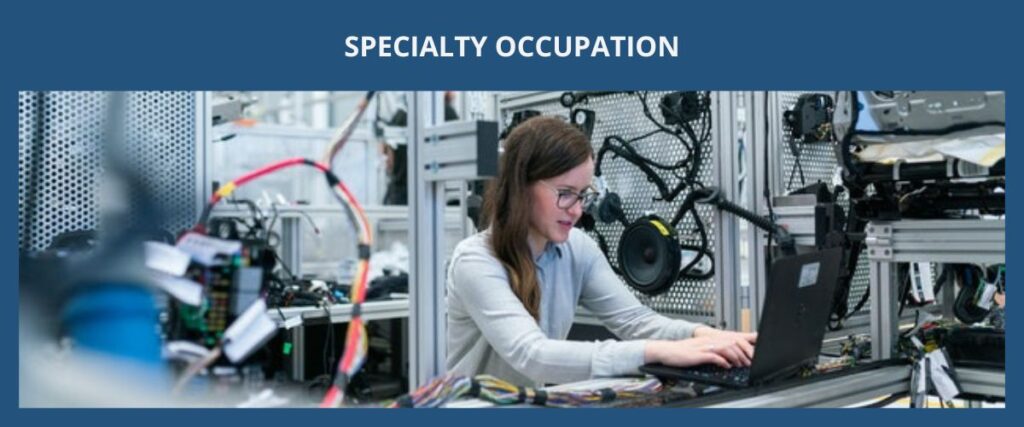
The job position normally requires a minimum of a bachelor’s degree (or its equivalent) in that specialty
One criterion to prove that the job position under the H1B visa petition is a specialty occupation requires the job position to normally ask for a minimum of a bachelor’s degree (or its equivalent) in that specialty.
Documents to Prepare (Job Position Normally Requires a Bachelor’s Degree)
Evidence that shows the H1B visa job position normally requires a minimum of a bachelor’s degree (or its equivalent) in that specialty can include but is not limited to:
- Documents from authoritative career resources (e.g., DOL’s Occupational Outlook Handbook) that shows the job duties, education, training, skills, work environment, and other qualification requirements for the specialty occupation (which should include descriptions on how the H1B visa job position offered is related to the occupation and how the degree requirement is needed for the H1B visa job position)
- Other documents showing that a bachelor’s degree (or its equivalent) is normally the minimum requirement for entry into that H1B visa job position
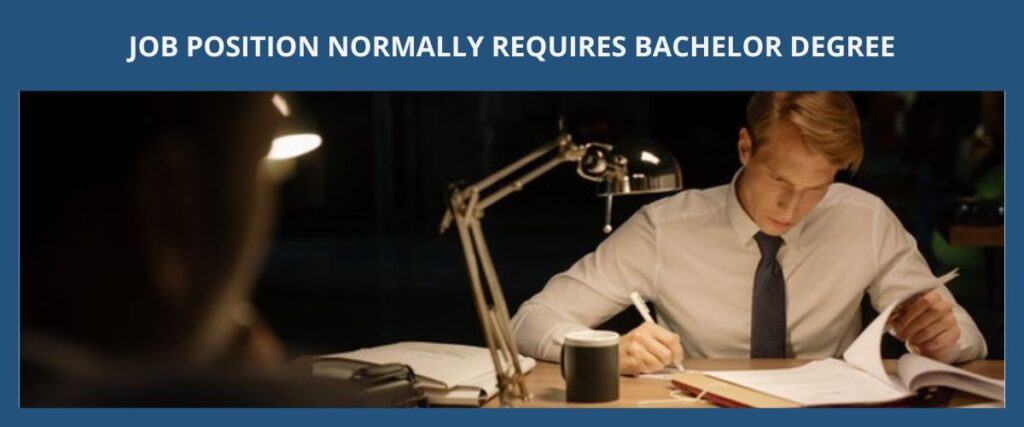
The U.S. sponsoring employer’s degree requirement is common for similar job positions in the industry
One criterion to prove that the job position under the H1B visa petition is a specialty occupation requires that the U.S. sponsoring employer’s degree requirement is common for similar job positions in the industry.
Documents to Prepare (Degree Requirement Common in Industry)
Evidence that shows the U.S. sponsoring employer’s degree requirement is common for similar job positions in the industry can include but is not limited to:
- Job postings or job advertisements that show the degree requirement of at least a bachelor’s degree (or its equivalent) is common to comparable job positions in similar organizations within the industry. The documents should include:
- The date and source
- Detailed description of the job duties
- Detailed description of the educational, training, and work experience required for the job position
- The organization is similar to the U.S. sponsoring employer and it is in the same industry
- The job posting or job advertisement for the job position represents industry standards
- Letters from professional associations related to the industry stating that similar organizations routinely recruit and employ persons that have at least a bachelor’s degree (or its equivalent) in the specific specialty for those types of job positions.
- Letters or affidavits from the organizations or persons within the industry attesting that similar organizations routinely recruit and employ persons that have at least a bachelor’s degree (or its equivalent) in the specific specialty for those types of job positions. It should include:
- The writer’s qualifications as an expert
- How the writer reached the conclusion
- The basis used for the conclusion (e.g., copies or citations of the articles used)
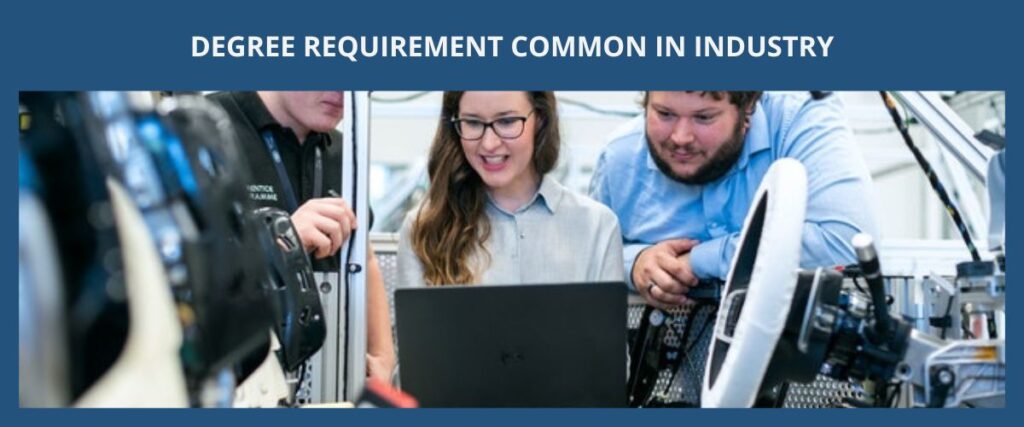
The nature of the specific job duties is so complex and specialized that it can only be performed by a person that has at least a bachelor’s degree (or its equivalent) in that specialty
One criterion to prove that the job position under the H1B visa petition is a specialty occupation requires that the nature of the specific job duties is so complex and specialized that it can only be performed by a person who has at least a bachelor’s degree (or its equivalent) in that specialty.
Documents to Prepare (Complex and Specialized Job Duties)
Evidence that shows the nature of the specific job duties is so complex and specialized that it can only be performed by a person that has at least a bachelor’s degree (or its equivalent) in that specialty can include but is not limited to:
- Explanation of the specific job duties related to the products and services, and how they are so complex and specialized that the knowledge required to perform them is usually by attainment of at least a bachelor’s degree (or its equivalent) in a specific field of study.
- Explanation of how the products and services are different from other employers in the same industry.
- Letters from professional associations related to the industry stating that the job position is so complex or unique that it can only be performed by a person with at least a bachelor’s degree (or its equivalent) in the specific specialty.
- Letters or affidavits from the organizations or persons within the industry attesting that the job position is so complex or unique that it can only be performed by a person with at least a bachelor’s degree (or its equivalent) in the specific specialty. The documents should include:
- The writer’s qualifications as an expert
- The writer’s knowledge of the U.S. sponsoring employer’s business
- How the writer reached the conclusion
- The basis used for the conclusion (e.g., copies or citations of the articles used)
Trade publications or other articles that show the nature of the U.S. sponsoring employer’s products and services and that the specific job duties are so complex and specialized that at least a bachelor’s degree (or its equivalent) in a specific field of study is required for the job position offered.
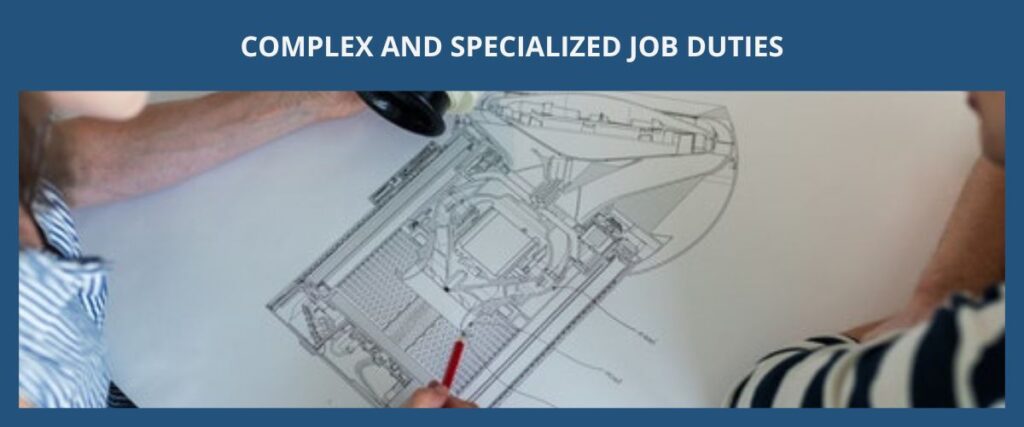
The U.S. sponsoring employer normally requires at least a bachelor’s degree (or its equivalent) for that job position
One criterion to prove that the job position under the H1B visa petition is a specialty occupation requires that the U.S. sponsoring employer normally asks for at least a bachelor’s degree (or its equivalent) for that job position.
Documents to Prepare (Employer Normally Requires a Bachelor’s Degree)
Evidence that shows U.S. sponsoring employer normally requires at least a bachelor’s degree (or its equivalent) for that job position can include but is not limited to:
- Organizational chart or diagram (which must include the hierarchy structure, staffing levels, education levels, field of study, and experience requirements for the job position)
- Current and past job postings or announcements for the proffered job position (or end-clients that the H1B visa worker will work for) requires applicants to have at least a bachelor’s degree (or its equivalent)
- Past employment practices for the job position:
- Documents that show the number of employees hired for the job position in the past 2 years
- Employment or pay records that show current or past employee in the job position
- Degrees or transcripts that show the field of study and level of education of each employee hired for the job position in the past 2 years
- Job duties, position descriptions, job postings, job offer letters, performance
- Documents that show the educational, training, skills, experience required for the position offered (which should include job position descriptions, job postings, job offer letters)
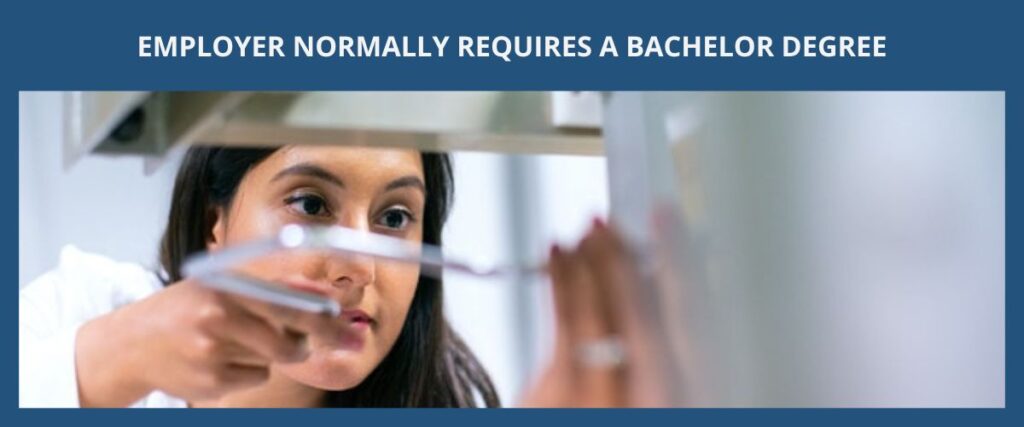
The H1B visa worker must have the required academic credentials (or its equivalent)
The H1B visa petition requires the H1B visa worker to have the required academic credentials or its equivalent. In most cases, the H1B visa worker would have a 4-year bachelor’s degree or a higher degree from an accredited U.S. college or university and it would be a degree that is required to enter the specialty occupation.
Foreign Degree
If the degree used for the H1B visa petition is obtained from a foreign institution (non-U.S. school), a credential evaluation would usually have to be done with a third-party academic evaluation agency to prove that the foreign degree is indeed the equivalent of a 4-year bachelor’s degree from an accredited U.S. institution.
Training or Work Experience
If the prospective H1B visa worker does not have the educational requirements, then work experience or training would need to be included to satisfy the minimum qualifications for the H1B visa job position.
H1B Visa Worker Qualifications
There are 4 main ways to show the H1B visa worker is qualified to perform the job duties of the offered H1B visa job position:
- (1)
- A bachelor’s degree (or a higher degree) from an accredited U.S. college or university that is required for the specific specialty occupation
- (2)
- A foreign degree from a college or university overseas which is determined as equivalent to a U.S. bachelor’s degree (or higher degree) required for the specific specialty occupation
- (3)
- A license, registration or certification to practice the specific specialty occupation if required by state law (e.g., attorney licenses, medical licenses)
- (4)
- Specific expertise obtained by a combination of education, training, or progressively responsible work experience in the specialty that can be determined as equivalent to the required degree
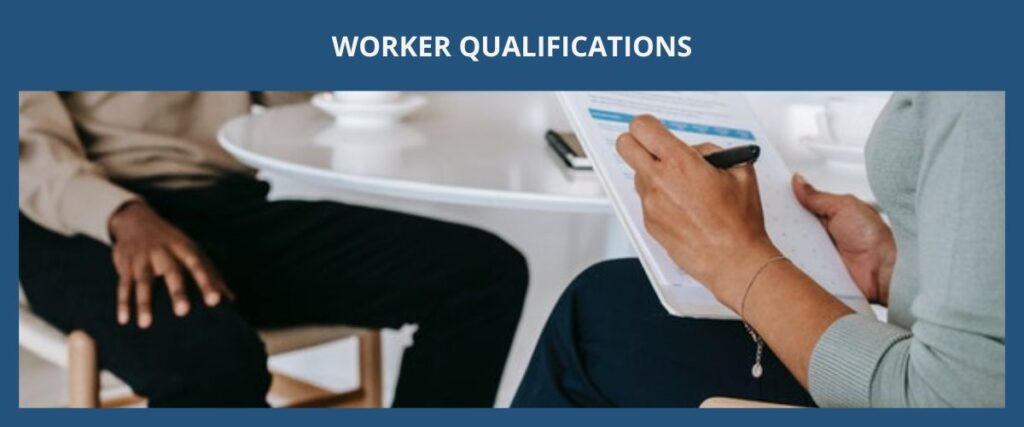
Substitutions of Degree
H1B visa job positions are in professional occupations that require workers to have at least a bachelor’s degree. The H1B visa worker is allowed to substitute degrees required by the job position with certain combinations of formal education, training, and work experiences.
Bachelor's Degree Substitution
H1B visa workers without a bachelor’s degree are allowed to substitute the required bachelor’s degree with specialized training and/or work experience. The H1B visa worker can use 3 years of specialized training and/or work experience to make up for each year (1 year) of college-level education that they are missing.
Master's Degree Substitution
H1B visa workers without a master’s degree are allowed to substitute the required master’s degree with a bachelor’s degree and at least 5 years of experience in the specialty.
Ph.D. Degree Cannot Be Substituted
H1B visa workers without a doctorate (Ph.D.) are not allowed to substitute the required doctorate degree which means that the H1B visa worker must have a doctorate degree (or its foreign equivalent) if the H1B visa job position requires for it.
Generalized Degrees
For H1B visa workers with generalized degrees (e.g., business administration, liberal arts), the classes that the person took during their study can be used to show that they are qualified for specific job positions. For example, an H1B visa worker with a business administration degree can show that they qualify for an accounting job position with the number of relevant accounting classes they took while obtaining their degree.
Temporary Licenses
If the H1B visa worker only holds a temporary license, the H1B visa can only be approved for a period of up to 1 year or the period that the temporary license is valid (whichever is longer) unless (1) the H1B visa worker is allowed to perform their job duties without a permanent license under supervision or (2) the state law allows a person without a license to practice the occupation under supervision even if the occupation usually requires a license.
Healthcare Professionals
Medical students in medical residency programs can qualify for an H1B visa even if they do not have a full and unrestricted U.S. medical license yet. Registered nurses (RN) typically do not qualify for an H1B visa because no state in the United States requires a Bachelor’s degree in a nursing license. However, advanced practice registered nurses (APRN) may be able to qualify for an H1B visa because of the advanced level of education and training required for their certification.
Documents to Prepare (H1B Visa Worker has the Required Qualifications)
Evidence that shows the H1B visa worker has the required qualifications of the H1B visa job position can include but is not limited to:
- Diplomas, degrees, certificates, licenses, professional organizational memberships
- Foreign academic evaluation (if academic records are not from U.S. educational institutions)
- Letters from former employers to verify past work experience
- Business records (e.g., contracts, invoices, proof of payment, letter from current or former clients) to show past work experience if self-employed

The U.S. sponsoring employer must be bona fide (real) and have the ability to pay the H1B visa worker
The H1B visa petition requires the U.S. sponsoring employer to real and have the ability to pay the H1B visa worker’s salary. An H1B visa petition cannot be filed without a U.S. employer sponsoring it (which means that foreign workers cannot apply for an H1B visa by themselves). A U.S. employer can include persons (e.g., agents), corporations, partnerships, sole proprietorships, or other organizations or associations in the United States with a tax identification number (Federal Employer Identification Number, FEIN) assigned by the International Revenue Service (IRS).
The documents that show the U.S. sponsoring employer has the ability to pay the wage offered to the H1B visa worker is typically provided if requested in a Request for Evidence (RFE) and not in the initial filing.
Documents to Prepare (Ability to Pay H1B Visa Worker)
Evidence that the U.S. sponsoring employer has the ability to pay the wage offered to the H1B visa worker can include but is not limited to:
- Federal income tax returns (it should include Forms 1120, 2220, 4562, 5472, 1065 and required schedules K, J-1, L, M-1) for the past 3 years
- State Quarterly Wage Report (which should include the name, salary, and number of weeks worked for all employees)
- Business licenses from the city, county, state and federal government
- Detailed description of the U.S. sponsoring employer’s organization. It should include:
o Company brochures
o Website
o Pamphlets
o Press releases
o Business plans
o Promotion materials
o Advertisements
o Patents
o Articles
o Other documents that show the U.S. sponsoring employer’s products or services
- Organizational chart or diagram (which should include the hierarchy structure, staffing levels, all divisions, identification of the H1B visa worker’s job position, names and job titles of the people listed)
- List the names and job titles of the H1B visa worker’s supervisors and subordinates
- List of all employees (which should include names, job titles, immigration status such as H1B, L1, E1, E2, F1, permanent resident, U.S. citizen)
- Description of the H1B visa worker’s specific workplace. It should include:
o Define the workplace (e.g., distribution, sales, office, representative agency)
o The type of building (e.g., warehouse, office suite, apartment, residence)
o How many hours the H1B visa worker will actually work at the location each week
o Business hours
- Documents that show business is being done (active) at the location. It should include:
o Utility bills
o Telephone bills
o Business licenses
o Payroll documents
o Rent receipts
o Bank statements
- Lease of the business premises must be signed and dated, and include:
o Monthly rental fee
o Total square footage of premises (which should include all office, manufacturing, production, warehouse spaces)
- Property records that show ownership of physical location if not renting
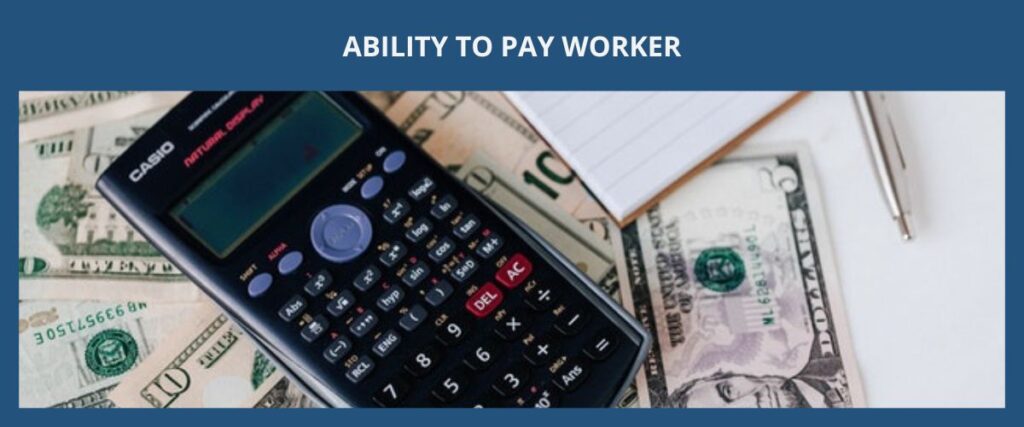
The U.S. employer must have an employer-employee relationship with the H1B visa worker
The H1B visa petition requires that the U.S. employer have an employer-employee relationship with the H1B visa worker. In other words, the H1B visa worker must be working for the U.S. sponsoring employer as an employee (which means that independent contractors are not qualified for H1B visa petitions).
Employer-Employee Relationship Determination
There is a qualified employer-employee relationship under the H1B visa when the U.S. sponsoring employer has the right to control the work of the H1B visa worker (e.g., hire, fire, supervision). The employer-employee relationship under the H1B visa can be determined by the following factors:
- Location of workplace
- Skill required to perform the specialty occupation work
- The source of tools and instrumentalities required to perform the specialty occupation work
- Duration of the relationship between the U.S. sponsoring employer and the H1B visa worker
- The U.S. sponsoring employer’s right to hire, fire, assign additional work, set rules and regulations on the H1B visa worker’s work
- The extent of discretion that the H1B visa worker has over how long and when to work
- Method of paying the H1B visa worker’s salary
- The H1B visa worker’s role in hiring and paying for assistants
- Whether the specialty occupation work is part of the U.S. sponsoring employer’s regular business
- Bonafide (i.e., real) business
- Employee benefits
- Tax treatment of the H1B visa worker
- The extent of supervision the U.S. sponsoring employer has on the H1B visa worker’s work
- Whether the H1B visa worker reports to someone higher in the organization
Documents to Prepare (Employer-Employee Relationship)
Evidence that shows the U.S. sponsoring employer must have an employer-employee relationship with the H1B visa fashion model can include but is not limited to:
- Written employment contract between the U.S. sponsoring employer and the H1B visa worker
- A summary of the terms of the oral agreement for the H1B visa worker’s employment
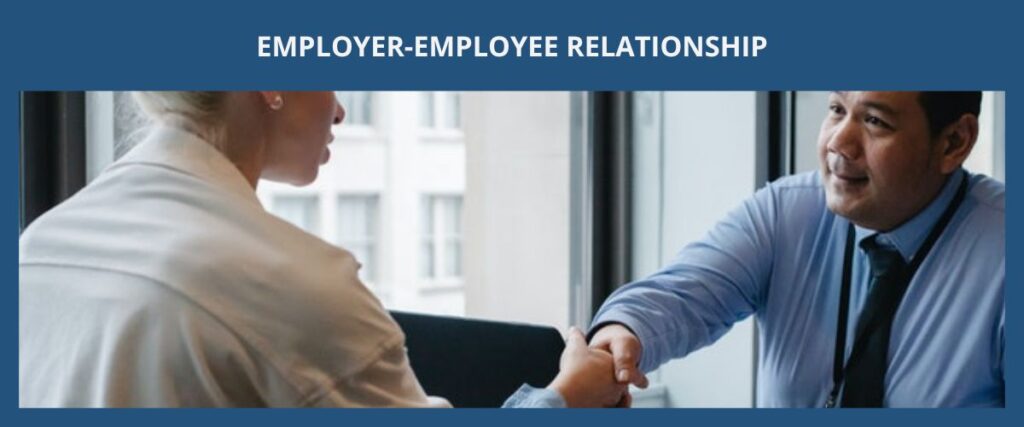
The U.S. sponsoring employer must have enough in-house specialty occupation work for the H1B visa worker to perform
The H1B visa petition requires that the U.S. sponsoring employer must have enough specific qualifying assignments in a specialty occupation for the H1B visa worker to perform. This requirement is to make sure that the business of the U.S. sponsoring employer actually needs a person to work in a specific professional job position (specialty occupation) and that it also has the capacity to hire an H1B visa worker to perform that type of work.
Documents to Prepare (Business Needs for Specialty Occupation Work)
Evidence that shows the U.S. employer has enough in-house specialty occupation work for the H1B visa worker to perform can include but is not limited to:
- Employment agreement (it should include the employment terms and be signed)
- Offer letter (which should include the description of the services to be performed by the H1B visa worker and the employer-employee relationship between the H1B visa worker and the U.S. sponsoring employer)
- Description of job position or other documents that shows:
o The skills required for the job position
o The tools required to perform the job
o The service to be provided
o Method of payment
o Products to be developed
o Whether the work is part of the U.S. sponsoring employer’s regular business
o Employee benefits
o Tax treatment
- Documents of actual work assignments (which may include marketing analysis, technical documentation, milestone tables, cost-benefit analysis, brochures, funding documents)
- Past work product created by current or past employees in similar positions. It should include:
o Reports
o Evaluations
o Designs
o Blueprints
o Presentations
- Documents to show in-house projects (which should include income and expense projections, market analyses, timelines, number of required workers, work locations)
- Documents of enough production space and equipment for the H1B visa worker’s specialty occupation work
- Detailed explanation of:
o The H1B visa worker’s job duties and responsibilities
o Percentage of time spent on each duty
o The reason why the work requires a person that has at least a bachelor’s degree (or its equivalent) in that specific specialty
o The required qualifications for the job position

The overall emphasis on the documents and requirements/criteria of a H1B visa petition is that the H1B visa job position is qualified as a specialty occupation (which is a professional job that requires at least a bachelor’s degree) and the H1B visa worker has the qualifications to work in the H1B visa job position. The H1B visas are commonly used for F1 visa students after they graduate from a U.S. college or university and are working on their OPT, however, it can also be used for foreign workers from all over the world (i.e., (H1B visa workers do not need to be physically in the United States or even been to the United States before).
The requirements for an H1B visa petition are extensive and while ticking the boxes of requirements sounds simple enough, figuring out what items should be included and strategizing how the petition is presented is not. It is common practice and strongly encouraged to obtain an attorney for employment-based nonimmigrant visa petitions.
The most common scenario under the H1B visa is where an F1 visa student graduates from a U.S. college or university with a bachelor’s degree or an advanced degree (e.g., master’s degree, Ph.D., MD, JD) and during their OPT is working for a U.S. employer that is willing to sponsor an H1B visa petition for them to continue working there. In some scenarios, the U.S. employer files an H1B visa petition for an F1 visa student while they are still attending school but have already completed all requirements of a qualifying degree.
Common Scenario Timeline
The following is an example of a generalized timeline for most F1 visa students to obtain an H1B work visa (please note the dates are not set in stone and can vary):
Approximate Timeline (in most cases) | Activities |
|---|---|
F1 Visa Student Graduate (May 2021): | The F1 visa student obtains a bachelor’s degree or a higher degree (e.g., master’s degree, Ph.D., MD, JD) from an accredited U.S. college or university. |
Working During OPT Time (June 2021 – June 2022):
The OPT time for STEM students may be from June 2021 – June 2024 | The F1 visa student works for a U.S. employer during their OPT time.
The U.S. sponsoring employer for the H1B visa petition would usually be the U.S. employer the F1 visa student is working for during their OPT time but it does not have to be (which means that another U.S. employer can file for the F1 visa student even if the F1 visa student has not ever worked for it in the past). |
U.S. Employer Sponsors H1B Visa Petition (March 2022):
Please note that there are 2 types of H1B visa petitions: Cap-exempt and Cap-subject. We are focused on the cap-subject H1B visa petitions here (which constitutes the majority of H1B visa cases). Cap-exempt H1B visa petitions can be filed anytime during the year which means it does not have the timeline restrictions like the cap-subject H1B visa petitions showed here. | A U.S. employer is willing to sponsor (file) an H1B visa petition for the F1 visa student which if approved will allow the F1 visa student to legally work in the United States for a total of 6 years.
The U.S. sponsoring employer will retain an immigration lawyer and start the preparation of documents for the H1B visa petition cap season in March (i.e., typically in the year after the F1 visa student graduation).
The F1 visa student would first need to be registered for the H1B visa petition. And when there are more H1B visa petitions filed than the annual quota allows that year, then the F1 visa student will have to enter the H1B visa lottery.
If the F1 visa student’s H1B visa petition is selected after the H1B visa lottery, then their case can continue on to be reviewed by the USCIS.
If the H1B visa petition is approved, then the F1 visa student can change into their H1B visa status on October 1 of that same year (i.e., the earliest start date for work under the initial H1B visa is October 1 of the year that the H1B visa petition was filed). F1 visa students who had their H1B visa petition filed while their OPT was still valid, then they can continue to legally work between the time when their OPT (EAD card) expired to October 1 of that same year under the H1B visa cap-gap rule. |
F1 Visa Student Changes into H1B Visa Status to Start Working (October 2022): | In most cases, the F1 visa student will change into their H1B visa status and start working for the U.S. sponsoring employer on October 1 of the year that the H1B visa petition was filed (i.e., typically in the year after the F1 visa student graduation).
Typically, F1 visa students would request for a change of status in their H1B visa petitions (i.e., to have their nonimmigrant F1 visa status change to the H1B visa status without leaving the United States) and in these cases they will be changed into an H1B visa status upon the listed start date in the H1B visa petition.
For other F1 visa students who may not be able to do a change of status (or have other reasons like needing to travel internationally before their H1B visa petition is approved), they must do consular processing at the U.S. consulate or embassy overseas (usually in their home country) and be admitted (fly back) to the United States for their H1B visa status to become active. |
Approximate Timeline (in most cases) | Activities |
|---|---|
F1 Visa Student Graduate (May 2021): | The F1 visa student obtains a bachelor’s degree or a higher degree (e.g., master’s degree, Ph.D., MD, JD) from an accredited U.S. college or university. |
Working During OPT Time (June 2021 – June 2022):
The OPT time for STEM students may be from June 2021 – June 2024 | The F1 visa student works for a U.S. employer during their OPT time.
The U.S. sponsoring employer for the H1B visa petition would usually be the U.S. employer the F1 visa student is working for during their OPT time but it does not have to be (which means that another U.S. employer can file for the F1 visa student even if the F1 visa student has not ever worked for it in the past). |
U.S. Employer Sponsors H1B Visa Petition (March 2022):
Please note that there are 2 types of H1B visa petitions: Cap-exempt and Cap-subject. We are focused on the cap-subject H1B visa petitions here (which constitutes the majority of H1B visa cases). Cap-exempt H1B visa petitions can be filed anytime during the year which means it does not have the timeline restrictions like the cap-subject H1B visa petitions showed here. | A U.S. employer is willing to sponsor (file) an H1B visa petition for the F1 visa student which if approved will allow the F1 visa student to legally work in the United States for a total of 6 years.
The U.S. sponsoring employer will retain an immigration lawyer and start the preparation of documents for the H1B visa petition cap season in March (i.e., typically in the year after the F1 visa student graduation).
The F1 visa student would first need to be registered for the H1B visa petition. And when there are more H1B visa petitions filed than the annual quota allows that year, then the F1 visa student will have to enter the H1B visa lottery.
If the F1 visa student’s H1B visa petition is selected after the H1B visa lottery, then their case can continue on to be reviewed by the USCIS.
If the H1B visa petition is approved, then the F1 visa student can change into their H1B visa status on October 1 of that same year (i.e., the earliest start date for work under the initial H1B visa is October 1 of the year that the H1B visa petition was filed). F1 visa students who had their H1B visa petition filed while their OPT was still valid, then they can continue to legally work between the time when their OPT (EAD card) expired to October 1 of that same year under the H1B visa cap-gap rule. |
F1 Visa Student Changes into H1B Visa Status to Start Working (October 2022): | In most cases, the F1 visa student will change into their H1B visa status and start working for the U.S. sponsoring employer on October 1 of the year that the H1B visa petition was filed (i.e., typically in the year after the F1 visa student graduation).
Typically, F1 visa students would request for a change of status in their H1B visa petitions (i.e., to have their nonimmigrant F1 visa status change to the H1B visa status without leaving the United States) and in these cases they will be changed into an H1B visa status upon the listed start date in the H1B visa petition.
For other F1 visa students who may not be able to do a change of status (or have other reasons like needing to travel internationally before their H1B visa petition is approved), they must do consular processing at the U.S. consulate or embassy overseas (usually in their home country) and be admitted (fly back) to the United States for their H1B visa status to become active. |
Approximate Timeline (in most cases) F1 Visa Student Graduate (May 2021): |
Activities The F1 visa student obtains a bachelor’s degree or a higher degree (e.g., master’s degree, Ph.D., MD, JD) from an accredited U.S. college or university. |
Approximate Timeline (in most cases) Working During OPT Time (June 2021 – June 2022):
The OPT time for STEM students may be from June 2021 – June 2024 |
Activities The F1 visa student works for a U.S. employer during their OPT time.
The U.S. sponsoring employer for the H1B visa petition would usually be the U.S. employer the F1 visa student is working for during their OPT time but it does not have to be (which means that another U.S. employer can file for the F1 visa student even if the F1 visa student has not ever worked for it in the past). |
Approximate Timeline (in most cases) U.S. Employer Sponsors H1B Visa Petition (March 2022):
Please note that there are 2 types of H1B visa petitions: Cap-exempt and Cap-subject. We are focused on the cap-subject H1B visa petitions here (which constitutes the majority of H1B visa cases). Cap-exempt H1B visa petitions can be filed anytime during the year which means it does not have the timeline restrictions like the cap-subject H1B visa petitions showed here. |
Activities A U.S. employer is willing to sponsor (file) an H1B visa petition for the F1 visa student which if approved will allow the F1 visa student to legally work in the United States for a total of 6 years.
The U.S. sponsoring employer will retain an immigration lawyer and start the preparation of documents for the H1B visa petition cap season in March (i.e., typically in the year after the F1 visa student graduation).
The F1 visa student would first need to be registered for the H1B visa petition. And when there are more H1B visa petitions filed than the annual quota allows that year, then the F1 visa student will have to enter the H1B visa lottery.
If the F1 visa student’s H1B visa petition is selected after the H1B visa lottery, then their case can continue on to be reviewed by the USCIS.
If the H1B visa petition is approved, then the F1 visa student can change into their H1B visa status on October 1 of that same year (i.e., the earliest start date for work under the initial H1B visa is October 1 of the year that the H1B visa petition was filed). F1 visa students who had their H1B visa petition filed while their OPT was still valid, then they can continue to legally work between the time when their OPT (EAD card) expired to October 1 of that same year under the H1B visa cap-gap rule. |
Approximate Timeline (in most cases) F1 Visa Student Changes into H1B Visa Status to Start Working (October 2022): |
Activities In most cases, the F1 visa student will change into their H1B visa status and start working for the U.S. sponsoring employer on October 1 of the year that the H1B visa petition was filed (i.e., typically in the year after the F1 visa student graduation).
Typically, F1 visa students would request for a change of status in their H1B visa petitions (i.e., to have their nonimmigrant F1 visa status change to the H1B visa status without leaving the United States) and in these cases they will be changed into an H1B visa status upon the listed start date in the H1B visa petition.
For other F1 visa students who may not be able to do a change of status (or have other reasons like needing to travel internationally before their H1B visa petition is approved), they must do consular processing at the U.S. consulate or embassy overseas (usually in their home country) and be admitted (fly back) to the United States for their H1B visa status to become active. |
The timeline above is just a simplified and generalized example, and there are also a variety of other factors and scenarios under the path for an F1 visa student to obtain an H1B visa status.
*The dates referenced in the above example are not set in stone and each individual case must be determined on a case-by-case basis.
The closest alternatives to the H1B work visa petition would be filing for an L1B visa petition which is for employees who have specialized knowledge of the multinational company, or O1 visas which is for people who have an extraordinary ability in the sciences, arts, education, business, or athletics. Similar work visas to the H1B visas that are for people from certain countries include E3 visas for Australians working in specialty occupations and TN visas for Canadian or Mexicans working in certain professional occupations.
Another possible alternative to filing an H1B visa petition would be to file for a green card petition which is a permanent immigrant visa and not a temporary work visa like the H1B visa. Typically, a person who is qualifiable for an H1B visa would choose to file for an EB2 green card (which are usually for people who has at least a master’s degree) or EB3 green card (which are usually for people who has at least a bachelor’s degree) due to certain similarities in the requirements. For more on green cards gained through work, please read the overview for employment-based green cards.
If you have an H1B visa (Bachelor’s Degree Specialty Occupation) immigration question, please fill out our contact us form or send us an email with some basic information about your background and your immigration needs. We will do our best to respond within 48 hours.
How we can help?
Kylie Huang Law’s immigration attorney will help identify whether the H1B visa is the appropriate nonimmigrant visa category for the client’s (or the client’s beneficiary’s) professional background and if there are other visa options for the client (or the client’s beneficiary). We will work closely with our client to prepare a convincing case for their (or it’s) H1B visa petition and we will also strategize on how the H1B visa petition should be presented to achieve the best chances of approval. It is strongly advised and common practice to retain an immigration attorney for an H1B visa petition due to the complexities in the immigration process and visa requirements.
What does the typical process look like to retain (hire) us?
- Step 1:
- Step 2:
- Step 3:
- Step 4:
- Step 5:
- a.
- b.
- c.
- Step 6:
- Step 7:
- Step 8:
- Fill out the form (with some basic information on what your immigration needs are)
- Sign up and log into the client portal to schedule an appointment online
- Attend scheduled appointment (typically a phone call or zoom meeting)
- Retainment (signing a contract to hire us)
- Start processing case
- Gathering required documents
- Preparing paperwork
- Confirming contents of documents that will be submitted
- Filing the case
- Following up on the status of the case
- Close the case when a final determination is issued
- Step 1:
- Step 2:
- Step 3:
- Step 4:
- Step 5:
- a.
- b.
- c.
- Step 6:
- Step 7:
- Step 8:
- Fill out the form (on what your immigration needs are)
- Sign up and log into the client portal to schedule an appointment
- Attend scheduled appointment (typically a phone call or zoom)
- Retainment (signing a contract to hire us)
- Start processing case
- Gathering required documents
- Preparing paperwork
- Confirming contents of documents that will be submitted
- Filing the case
- Following up on the status of the case
- Close the case when a final determination is issued
- Step 1:
- Step 2:
- Step 3:
- Step 4:
- Step 5:
- a.
- b.
- c.
- Step 6:
- Step 7:
- Step 8:
- Fill out the form (on what your immigration needs are)
- Sign up and log into the client portal to schedule appointment
- Attend scheduled appointment (typically a phone call or zoom)
- Retainment (hire us)
- Start processing case
- Gathering required documents
- Preparing paperwork
- Confirming content of documents that will be submitted
- Filing the case
- Following up on the case status
- Close the case when a final determination is issued
RELATED ARTICLES
- H2A Visa (Agricultural Workers)
- H2A Visa Checklist (Agricultural Workers)
- TN Visa (NAFTA Professionals)
- E3 Visa (Australian Specialty Workers)
- L Visa Overview (Intra-Company Transferee)
- P visa Overview (Athlete & Entertainer)
- O Visa Overview (Extraordinary Ability / Achievement)
- E Visa Overview (Treaty Trader & Investor)
- Employment-Based Green Card Overview

